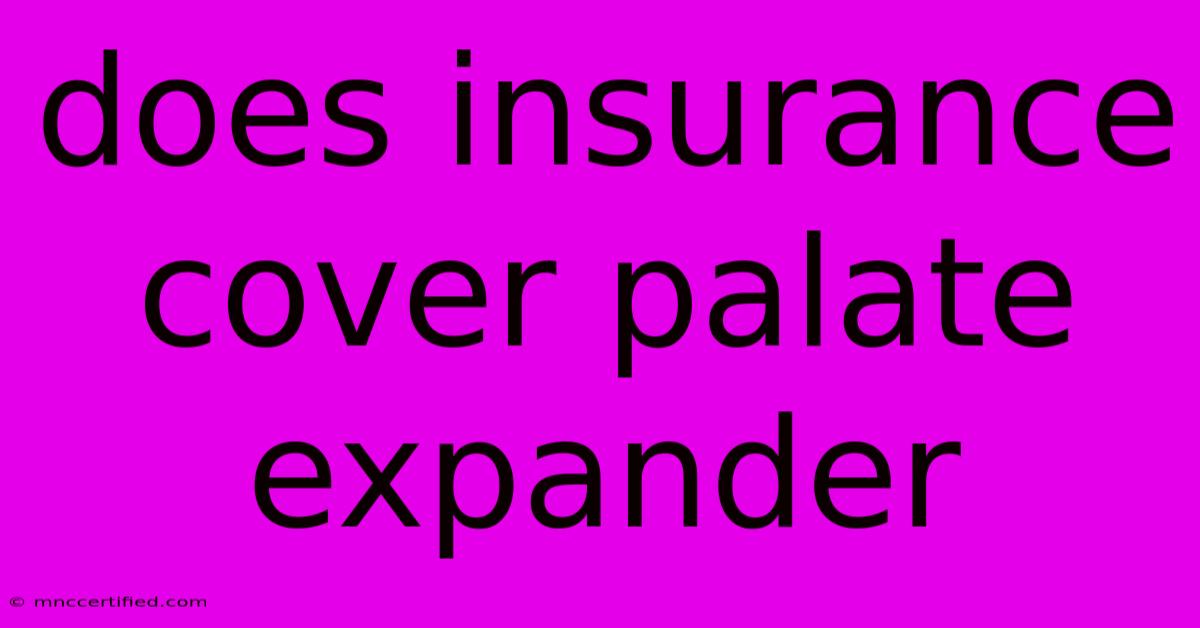Does Insurance Cover Palate Expander

Table of Contents
Does Insurance Cover Palate Expanders? A Comprehensive Guide
Expanding your palate might seem like a cosmetic procedure, but it’s often a crucial step in treating various dental issues, especially in children. However, insurance coverage for palate expanders can be a complex and confusing topic. This guide aims to provide clarity on the factors that influence coverage and help you navigate the process.
Understanding Palate Expanders and Their Purpose
A palate expander is a dental appliance used to widen the upper jawbone. This process, known as palatal expansion, addresses various issues including:
- Crowded teeth: Expanding the palate creates more space for teeth to align properly.
- Crossbite: This occurs when upper teeth bite inside the lower teeth.
- Underbite: A condition where the lower jaw protrudes beyond the upper jaw.
- Cleft palate: A birth defect that can affect the roof of the mouth.
Factors Influencing Insurance Coverage for Palate Expanders
Several factors determine whether your insurance covers palate expanders:
1. Your Insurance Plan:
- Dental insurance: Check your dental insurance plan for coverage of orthodontic appliances. Most plans cover a portion of the cost, often with a deductible and co-pay.
- Medical insurance: In some cases, medical insurance may cover palate expanders, particularly when addressing cleft palate or other medically necessary conditions.
- Type of plan: PPO (Preferred Provider Organization) plans offer more flexibility, while HMO (Health Maintenance Organization) plans have more restrictions.
2. Age:
- Children and adolescents: Insurance plans are more likely to cover palate expanders for children and teenagers undergoing orthodontic treatment.
- Adults: Coverage for adults is less common, as palate expanders are usually associated with childhood dental development.
3. Diagnosis:
- Medical necessity: Insurance companies generally cover palate expanders when they are medically necessary to treat a specific condition. Documentation from your orthodontist detailing the medical necessity is crucial.
- Cosmetic reasons: If the primary reason for the palate expander is purely cosmetic, coverage is less likely.
4. Provider:
- In-network providers: Using in-network orthodontists usually results in better coverage and lower out-of-pocket costs.
- Out-of-network providers: Check with your insurer about potential coverage for out-of-network providers, but be prepared for higher costs.
5. Pre-authorization:
- Requirement: Most insurance plans require pre-authorization for orthodontic treatments, including palate expanders.
- Process: Contact your insurance company to understand the process for pre-authorization.
Tips for Navigating Insurance Coverage
- Review your plan: Carefully read your dental and medical insurance plans to understand the coverage for orthodontic treatments.
- Consult your orthodontist: Discuss your insurance coverage with your orthodontist. They can provide guidance on pre-authorization and treatment options.
- Contact your insurance company: Ask about pre-authorization procedures, coverage details, and any necessary documentation.
- Explore payment options: Consider alternative payment options, like financing plans or payment plans offered by your orthodontist.
Conclusion
Insurance coverage for palate expanders can be complex, depending on your specific plan, age, diagnosis, and provider. However, by understanding the factors involved and following the tips outlined above, you can increase your chances of receiving coverage and making informed decisions about your treatment. Remember to communicate with your orthodontist and insurance company to ensure a smooth and cost-effective process.

Thank you for visiting our website wich cover about Does Insurance Cover Palate Expander. We hope the information provided has been useful to you. Feel free to contact us if you have any questions or need further assistance. See you next time and dont miss to bookmark.
Featured Posts
-
George Gandy Insurance Farmington Nm
Nov 11, 2024
-
Motorist Commercial Mutual Insurance
Nov 11, 2024
-
Are Naturopaths Covered By Insurance
Nov 11, 2024
-
Abd Insurance And Financial Services
Nov 11, 2024
-
Inter Miami Eliminated From Mls Playoffs
Nov 11, 2024